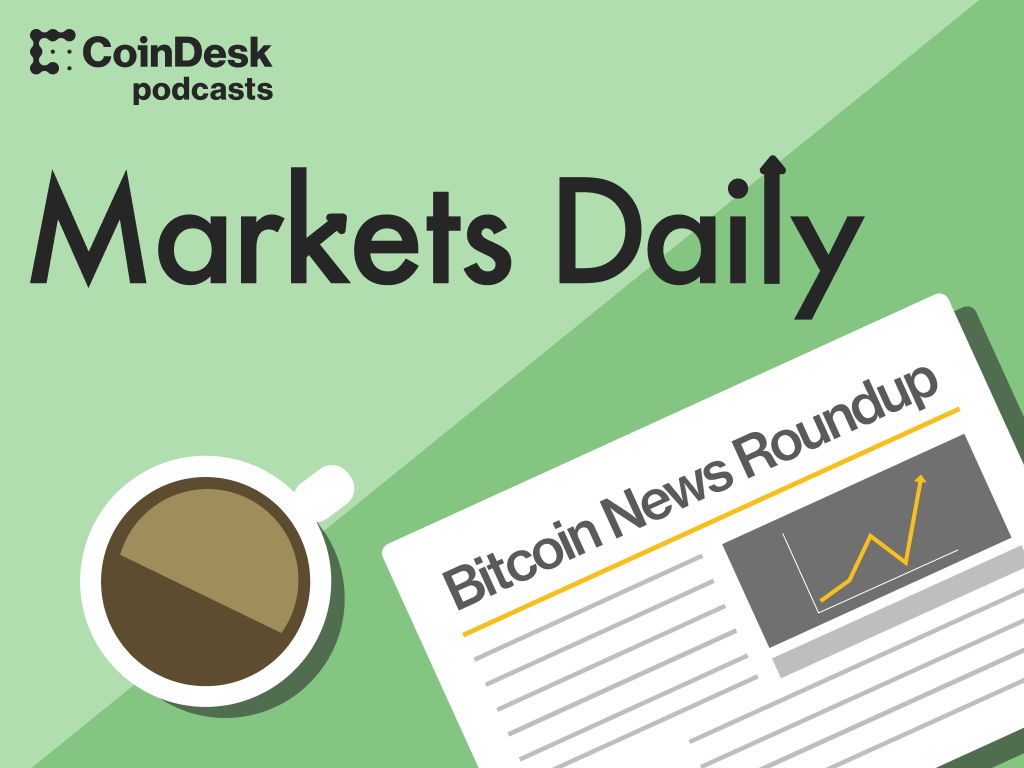Today’s episode is sponsored by CME Group.
To get the show every day, follow the podcast here.
Today’s Stories:
Mt. Gox Appears to Have Started PayPal Repayments Tied to 2014 Bitcoin Hack
Infamously Hacked Crypto Exchange Mt. Gox Delays Bitcoin (BTC) Repayment Deadline by a Year
CoinDesk Turns 10: The Legacy of Mt. Gox – Why Bitcoin’s Greatest Hack Still Matters
From our sponsors:
CME Group Cryptocurrency futures and options provide market-leading liquidity for bitcoin and ether trading. These cash-settled contracts give full exposure to crypto performance without the hassle of holding the physical position. No digital wallet? No problem. Trade nearly 24/7 in a transparent, CFTC-regulated market. Visit cmegroup.com/crypto to learn more.
Disclaimer:
This communication is not directed to investors located in any particular jurisdiction and is not intended to be accessed by recipients based in jurisdictions in which distribution is not permitted. The information herein should not be considered investment advice or the results of actual market experience. Past results are not necessarily indicative of future performance. Trading derivatives products involves the risk of loss. Please consider carefully whether futures or options are appropriate to your financial situation.
This episode was hosted by Noelle Acheson. “Markets Daily” is executive produced by Jared Schwartz and produced and edited by Eleanor Pahl. All original music by Doc Blust and Colin Mealey.
Audio Transcript: This transcript has not been edited and may contain errors.
It’s Thursday, December 28th, 2023 and this is Markets Daily from CoinDesk. My name is Noelle Acheson, CoinDesk collaborator and author of the Crypto is Macro Now newsletter on Substack. On today’s show we’re talking about ether outperformance, inflation expectations, Mt. Gox, and more. So you don’t miss an episode, be sure to follow the podcast on your platform of choice, and turn on notifications. And just a reminder, CoinDesk is a news source and does not provide investment advice.
Now, a markets roundup.
In crypto markets, after a relatively uneventful few days, ether is outperforming! The second largest token by market cap soared past $2,400 dollars earlier today. Although it has since pulled back some, it is so far holding on to most of its gains while the rest of the market is showing signs of weakness.
According to CoinDesk Indices, at 9 a.m. Eastern time today, bitcoin was trading down three tenths of a percent, at 42,785 dollars. Ether, on the other hand, was trading up 4.2%, at 2,394 dollars. Elsewhere, Solana was down more than 9%, Avalanche was down more than 8%, Optimism was down 6%.
In macro matters, we’re back to talking about U.S. inflation, which continues to show signs of easing. Last Friday, we got the Fed’s preferred inflation gauge, the core personal consumption expenditures price index which strips out food and energy.
In the month of November, the index increased 0.1% from a month earlier after a downwardly revised 0.1% gain in October. This was lower than the consensus forecast of 0.2%. The year-on-year increase was 3.2%, lower than the consensus forecast of 3.3% and notably lower than October’s 3.4%. Even better, on a six-month annualized basis, the core metric rose only 1.9%, the first time in more than three years that this measure fell below the Fed’s official inflation target of 2%.
And in another piece of good news, the University of Michigan consumer survey data also out on Friday showed a sharp drop in inflation expectations, which the Fed does pay attention to. The survey confirmed that consumers are now factoring in inflation 12 months out of 3.1%, down from 4.5% in November.
Does this mean that U.S. rate hikes are officially over? Yes, it probably does. But it does not mean that inflation is over.
Income data out on Friday showed robust income growth, which could fuel an uptick in consumer spending and inflation, especially if energy prices climb due to winter demand and supply chain disruption.
Expectations of a rate cut as soon as January have risen to almost 20% from 0% a month ago, according to futures pricing. And the consensus for the end of 2024 seems to be now for between six and seven rate cuts, versus the Fed’s expectation of two.
In sum, we’re seeing good news on inflation – but there’s a legitimate concern that the market is pricing in a bit too much good news.
In quiet trading yesterday, U.S. stock indices were largely flat. Futures pricing this morning suggests that today’s trading could be similar.
In Europe, the main stock indices were also muted, with the FTSE 100 up four tenths of a percent, the German DAX and the broader Eurostoxx 600 up two tenths. Trading so far this morning is mixed.
In Asia trading today, moves were more pronounced but also mixed. Japan’s Nikkei index dropped four tenths of a percent, the Shanghai Composite rose 1.4% and the Hang Seng climbed 2.5%.
In commodities, oil prices continue to trend lower as traders are back to focusing less on supply chain risk and more on declining demand from a weaker global economy. Earlier today, the Brent Crude benchmark was trading down two thirds of a percent, at 78 dollars and 82 cents.
Gold, on the other hand, continues to climb, passing above 2,080 dollars an ounce earlier today.
Stay with us – after the break we’re going to look at something that seems to be making many bitcoin investors nervous, but isn’t really a cause for concern.
Welcome back!
A couple of days ago, CoinDesk reported that some creditors from the collapsed Mt. Gox exchange were receiving long-awaited payments. This triggered some concerns that a wave of sell orders was incoming. In this section, I’m going to explain why that is unlikely.
First, some back story for those of you who weren’t trading crypto in 2014.
Back then, the largest crypto exchange by far was Mt. Gox, which at one point accounted for around 70% of the crypto market.
In an implosion reminiscent of what we all went through in 2022 with the collapse of FTX, it turned out that Mt. Gox was not as robust as it seemed. After months of reports of delays in fund withdrawals, and a stream of technical issues, the website went dark on the 24th of February, 2014. A few days later, the exchange filed for bankruptcy, and revealed that around 850,000 bitcoins had been lost. This was around 7% of all bitcoins in circulation, and with bitcoin trading under $600 dollars, was worth around $470 million.
At the time, this was catastrophic news, which many have argued was a much bigger blow to the ecosystem than the FTX fraud. The impact may have been more localized and smaller in dollar terms, but the industry was so young that it was not a given it would bounce back. When FTX went down just over a year ago, no-one doubted that the market would eventually come back. This was not the case in 2014.
Over the years, the appointed liquidators have managed to recover around 20% of the missing bitcoin.
142,000 bitcoin are set to be distributed to claimants, and the concern is that those receiving the payout will instantly sell, pushing down the market price.
The schedule for payouts has been delayed so many times I’ve lost count – the most recent delay was in September of this year, when the window was pushed back to the year ending in October 2024.
But, almost 10 years later, it appears that some claimants are finally getting repaid. For now it seems to be limited to a subset of those who have opted to receive cash payments in yen – some participants in a subreddit group said they have received payouts in their Paypal accounts, while those who have chosen to receive bank transfers are still waiting.
Those who have chosen to receive payments in bitcoin will probably have to wait a bit longer as the liquidator apparently still needs to square away a lot of details. The question is, what will these holders do when they get their collective 142,000 tokens?
In my opinion, it’s unlikely that we will see a wave of selling.
One reason is that those affected are early bitcoin adopters – many could choose to hold on to the transferred tokens in the hopes that the value will rise even further.
Another is that the repayments are likely to be spread out over a period of weeks or possibly months, going channel by channel and jurisdiction by jurisdiction.
A third reason is that even those who do want to sell may be reluctant to incur a tax event. Obviously, the value of these bitcoin has increased a lot over the years – 8,500 percent, to be more precise. That’s some hefty capital gains there.
And finally, in this market, with current tailwinds likely to propel bitcoin prices higher, any selling would be able to find buyers, especially on any price dips.
Stepping back, once all the distributions have been completed, we will be able to breathe a sigh of relief that one of crypto’s most infamous moments is completely over. And we can look forward to being able to say the same about the FTX liquidations – let’s hope they don’t take quite as long.
Thanks for listening – That’s it for today’s show!
Read the full article here









